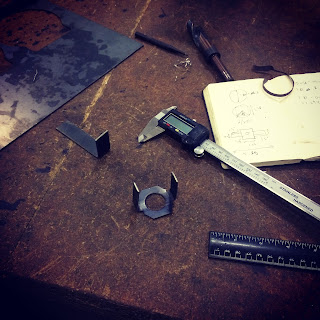Pace of development has definitely slowed down, as almost all of my time these days is dedicated to Mocobe, but I was feeling lazy today so we walked down to Balompie #3 and had pupusas for lunch, and then I spent some time in the afternoon tinkering with the drive train. I've been working on it on the weekends a bit, and instead of building it all in one go, I decided that for something this complex, I was going to try roughing it out first. This gave me a good opportunity to try a few things out and fix problems as they arose before I settled on a final design, without having to machine a lot of parts and drill a ton of holes in steel.
I used scrap aluminum plate, and did the work in my basement, with an angle grinder to cut the aluminum and a hand drill to drill the holes, which is a lot faster than drilling holes in steel with a drill press. Fortunately, as well, I have a good sized collection of clamps, so instead of drilling into the frame, I just clamped the pieces onto it, making it easy to adjust them, remove them, and move them around. To attach the chain to the shuttle, I made a really janky attachment point with duct tape, some wood, and a couple of eye hooks. Eventually I'll weld an attachment point onto the shuttle, but I wanted to test this out first.

I'm also thinking that a faster motor would be good. This is running flat out, and it's got way more torque than it needs. I'd rather get something faster, and be able to run it at slower speed using the speed controller if I need to. I bought this one from Servocity, which runs at 118 RPM max speed, but I could just swap it out for the 313 RPM unit and I'm pretty sure the torque will be plenty.
I used scrap aluminum plate, and did the work in my basement, with an angle grinder to cut the aluminum and a hand drill to drill the holes, which is a lot faster than drilling holes in steel with a drill press. Fortunately, as well, I have a good sized collection of clamps, so instead of drilling into the frame, I just clamped the pieces onto it, making it easy to adjust them, remove them, and move them around. To attach the chain to the shuttle, I made a really janky attachment point with duct tape, some wood, and a couple of eye hooks. Eventually I'll weld an attachment point onto the shuttle, but I wanted to test this out first.
Here's the drive train in action:
Some notes from the build:
One thing that's different from the previous version is that I added a 15 x 20 mm cable carrier to the hose.
It's actually two, bolted together. The problems I was having with the hose tracking properly are totally solved by this, the hose bends fine and doesn't get tangled in the rails at all. Since I haven't machined the sheet cladding for the whole thing yet, I hope that it will still work okay when it's constrained.
I had to make a bunch of adjustments as I was getting the drive train to work: the tensioning gear here is critical for holding the chain against the drive gear. Otherwise the whole thing slips, there's too much play in a chain that long. It's also really important to get these three gears aligned properly:

Otherwise, it puts a lot of strain on the swivels. I bought swivel hubs from Servocity for mounting the sprockets (also available at Sparkfun) and found them to be junk. The free-play of the hubs is bad, and they repeatedly fell apart when they were used under strain. The halves are simply held together with a nylon lock nut and a bolt. Presumably the idea is that the lock nut prevents the bolt from loosening (or tightening!) and the halves will just rotate against the washer, without moving the bolt. In practice, I found that in use, the hubs either fell apart or seized up due to over-tightening, depending on the direction of rotation. It's possible that this was due to lateral strain from misalignment of the chain, which caused pressure on the washer. In the end, I don't care why, they're not robust enough for this application. I wound up disassembling the ones that were failing and just putting a bolt through one half, and leaving it mostly tightened. That was fine for the time being.
I'm also thinking that a faster motor would be good. This is running flat out, and it's got way more torque than it needs. I'd rather get something faster, and be able to run it at slower speed using the speed controller if I need to. I bought this one from Servocity, which runs at 118 RPM max speed, but I could just swap it out for the 313 RPM unit and I'm pretty sure the torque will be plenty.
I haven't decided on the design of the chain attachment point for the shuttle, but I'm thinking it might be handy to have some sort of short linear tensioner, like just a screw with 1" travel. Being able to link the chain on and then screw it down to tighten would make life a lot easier.
Also, it turns out that my bicycle chain breaker doesn't work for this roller chain because the pitch is different, which isn't surprising. I can try doing it the old fashioned way by just pounding out a rivet, but last time I tried that with a bike chain I smashed a finger. Or I could just cut it. I looked for a 0.25 roller chain breaker, and found this one on Amazon, but since it's made by Koch Industries, I won't be buying it.



































